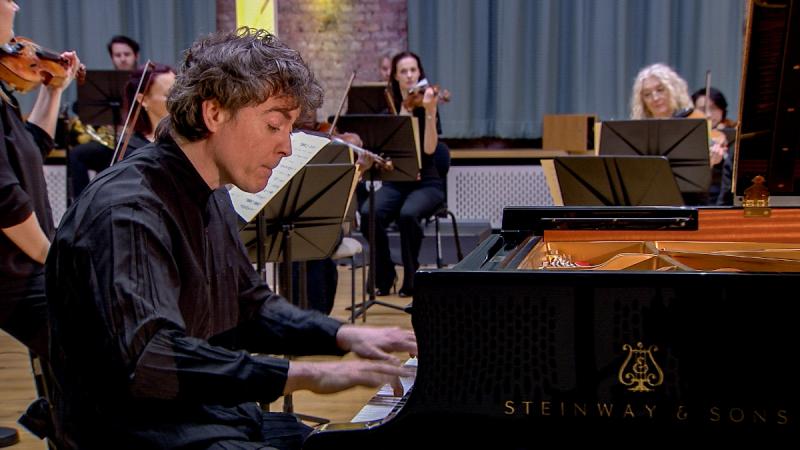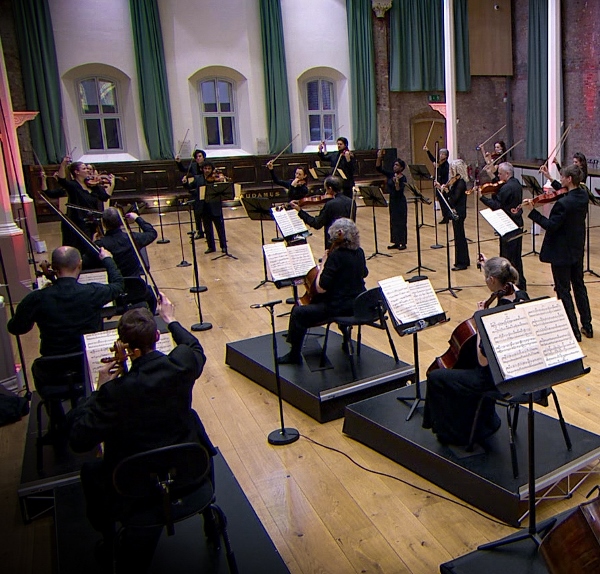Lewis, Hallé, Thórarinsdóttir online review - serenity and spice | reviews, news & interviews
Lewis, Hallé, Thórarinsdóttir online review - serenity and spice
Lewis, Hallé, Thórarinsdóttir online review - serenity and spice
More music as cinema from the orchestra’s Manchester centre

For the newest performance of their part-postponed “Winter Season” on film, the Hallé return to their rehearsal and performance centre in Ancoats, and with the help of piano soloist-director Paul Lewis and guest leader-director Eva Thórarinsdóttir offer a display of the capability of their orchestra members as chamber musicians.
So first we see again the little sequence of musicians heading through Manchester city centre to Hallé St Peter’s, and before the music starts Paul Lewis introduces Mozart’s Piano Quintet in E flat K452, and Sergio Castelló-López, clarinet, and Elena Comelli, bassoon, chat to him about it (with a few black and white rehearsal clips).
Joined by Stéphane Rancourt, oboe, and Laurence Rogers, horn, they embark on the music proper, and that is an absolute treat. If there is a word to sum up their quality of this work as they perform it, it is “serenity”. The idea of music as healing balm may have been uppermost in many minds as this was created: if so, it communicates from the Largo opening of the first movement, and the atmosphere scarcely changes with the tempo switch to allegro – all suavity and calm.

Visually, the five are nicely positioned in an upside-down V shape with Paul Lewis and the piano at the apex, and the sound is finely balanced and mellow, as the cameras pan around them as well as bringing close-ups and more static shots. The central Larghetto is one of those slow, operatic-ensemble-style movements of breathtakingly interwoven melodies that only Mozart could create, with the beguiling subtleties of his writing brought here to elegant life. And when the final Allegretto strikes up its seemingly steady pulse, keeping tension well moderated, we realise there’s method in the moderation as the piano’s role is dazzling enough once triplet semi-quavers begin to abound.
The second item on this three-course menu is a wonderfully spicy contrast: Stravinsky’s Concerto in D for strings. There’s more film chat to introduce it, which I found highly entertaining. Eva Thórarinsdóttir (pictured in performance with the Hallé strings) talks with Simon Turner, cello, and Paulette Bayley, violin, in the kind of fresh, hair-let-down way musicians sometimes think is not for the record but is full of insight and imagination. “It’s pure chaos” (Eva) … the slow movement is “like a ballroom where everyone’s been lobotomized” (Simon) … we’re in a dreamworld (Paulette). Sure enough, their enthusiasm over a work which, for most, was apparently a new discovery, translates into the playing. It’s one of those works Stravinsky wrote for Paul Sacher’s chamber orchestra, and quirky in the extreme. The playing of the Arioso (the lobotomized ballroom) is gorgeously schmaltzy and insinuating, and the final fast Rondo comes out frantic and yet precise, with everyone enjoying the surprise ending.
Back to Mozart for the rest: Lewis gives a brief introduction, and then with the assembled chamber orchestra plays the A major Piano Concerto K414.. Relaxation is now the chief characteristic of the performance, in its charming and sunny opening Allegro, though it all melts into haunting introspection for the wistful slow movement (it quotes a melody by Johann Christian “the English” Bach, from whom Mozart had learnt so much in his younger years and whose death may have inspired this quiet effusion).
Lewis plays the seemingly innocent and naïve melodic lines with exquisite phrasing and beautifully poised points of emphasis: he keeps display in the cadenzas and lead-ins to a modest minimum, allowing himself just the luxury of a relatively big one in the final Allegretto, as fun and freedom assert themselves for the last ritornello.
rating
Explore topics
Share this article
The future of Arts Journalism
You can stop theartsdesk.com closing!
We urgently need financing to survive. Our fundraising drive has thus far raised £49,000 but we need to reach £100,000 or we will be forced to close. Please contribute here: https://gofund.me/c3f6033d
And if you can forward this information to anyone who might assist, we’d be grateful.

Subscribe to theartsdesk.com
Thank you for continuing to read our work on theartsdesk.com. For unlimited access to every article in its entirety, including our archive of more than 15,000 pieces, we're asking for £5 per month or £40 per year. We feel it's a very good deal, and hope you do too.
To take a subscription now simply click here.
And if you're looking for that extra gift for a friend or family member, why not treat them to a theartsdesk.com gift subscription?
more Classical music
 Goldscheider, Brother Tree Sound, Kings Place - music of hope from a young composer
Unusual combination of horn, strings and electronics makes for some intriguing listening
Goldscheider, Brother Tree Sound, Kings Place - music of hope from a young composer
Unusual combination of horn, strings and electronics makes for some intriguing listening
 Helleur-Simcock, Hallé, Wong, Bridgewater Hall, Manchester review - moving lyricism in Elgar’s concerto
Season opener brings lyrical beauty, crisp confidence and a proper Romantic wallow
Helleur-Simcock, Hallé, Wong, Bridgewater Hall, Manchester review - moving lyricism in Elgar’s concerto
Season opener brings lyrical beauty, crisp confidence and a proper Romantic wallow
 Kohout, Spence, Braun, Manchester Camerata, Huth, RNCM, Manchester review - joy, insight, imagination and unanimity
Celebration of the past with stars of the future at the Royal Northern College
Kohout, Spence, Braun, Manchester Camerata, Huth, RNCM, Manchester review - joy, insight, imagination and unanimity
Celebration of the past with stars of the future at the Royal Northern College
 Jansen, LSO, Pappano, Barbican review - profound and bracing emotional workouts
Great soloist, conductor and orchestra take Britten and Shostakovich to the edge
Jansen, LSO, Pappano, Barbican review - profound and bracing emotional workouts
Great soloist, conductor and orchestra take Britten and Shostakovich to the edge
 Jakub Hrůša and Friends in Concert, Royal Opera review - fleshcreep in two uneven halves
Bartók kept short, and a sprawling Dvořák choral ballad done as well as it could be
Jakub Hrůša and Friends in Concert, Royal Opera review - fleshcreep in two uneven halves
Bartók kept short, and a sprawling Dvořák choral ballad done as well as it could be
 Hadelich, BBC Philharmonic, Storgårds, Bridgewater Hall, Manchester review - youth, fate and pain
Prokofiev in the hands of a fine violinist has surely never sounded better
Hadelich, BBC Philharmonic, Storgårds, Bridgewater Hall, Manchester review - youth, fate and pain
Prokofiev in the hands of a fine violinist has surely never sounded better
 Monteverdi Choir, ORR, Heras-Casado, St Martin-in-the-Fields review - flames of joy and sorrow
First-rate soloists, choir and orchestra unite in a blazing Mozart Requiem
Monteverdi Choir, ORR, Heras-Casado, St Martin-in-the-Fields review - flames of joy and sorrow
First-rate soloists, choir and orchestra unite in a blazing Mozart Requiem
 Cho, LSO, Pappano, Barbican review - finely-focused stormy weather
Chameleonic Seong-Jin Cho is a match for the fine-tuning of the LSO’s Chief Conductor
Cho, LSO, Pappano, Barbican review - finely-focused stormy weather
Chameleonic Seong-Jin Cho is a match for the fine-tuning of the LSO’s Chief Conductor
 Classical CDs: Shrouds, silhouettes and superstition
Cello concertos, choral collections and a stunning tribute to a contemporary giant
Classical CDs: Shrouds, silhouettes and superstition
Cello concertos, choral collections and a stunning tribute to a contemporary giant
 Appl, Levickis, Wigmore Hall review - fun to the fore in cabaret and show songs
A relaxed evening of light-hearted fare, with the accordion offering unusual colours
Appl, Levickis, Wigmore Hall review - fun to the fore in cabaret and show songs
A relaxed evening of light-hearted fare, with the accordion offering unusual colours
 Lammermuir Festival 2025, Part 2 review - from the soaringly sublime to the zoologically ridiculous
Bigger than ever, and the quality remains astonishingly high
Lammermuir Festival 2025, Part 2 review - from the soaringly sublime to the zoologically ridiculous
Bigger than ever, and the quality remains astonishingly high
 BBC Proms: Ehnes, Sinfonia of London, Wilson review - aspects of love
Sensuous Ravel, and bittersweet Bernstein, on an amorous evening
BBC Proms: Ehnes, Sinfonia of London, Wilson review - aspects of love
Sensuous Ravel, and bittersweet Bernstein, on an amorous evening

Add comment